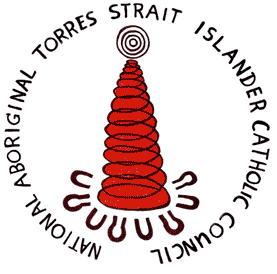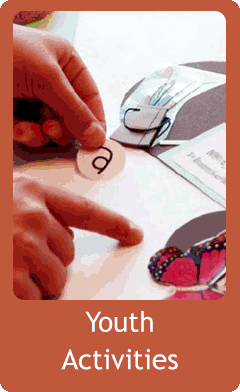
National Aboriginal and Torres Strait Islander Catholic Council
2017 Aboriginal and Torres Strait Islander Sunday Resources
Faith Stones
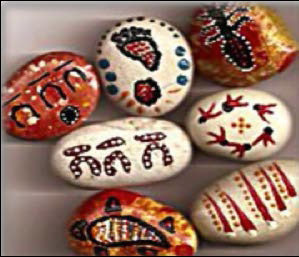 Each stone is unique and they are an excellent medium to show that although they are different, they are all important and precious in God’s eyes. This activity gives students the opportunity to express their concept of faith and teachers/supervisors may take the opportunity to invite and Aboriginal or Torres Strait Islander person along to lead the activity.
Each stone is unique and they are an excellent medium to show that although they are different, they are all important and precious in God’s eyes. This activity gives students the opportunity to express their concept of faith and teachers/supervisors may take the opportunity to invite and Aboriginal or Torres Strait Islander person along to lead the activity.
Students should be encouraged to use thought and imagination in depicting their faith through painting the rock.
Whilst the stones are drying, encourage students to talk about what they painted and how there are similarities and differences in each painting.
Once finished, they could be arranged in your prayer space or classroom.
Materials:
• Stones (palm sized) - smooth and clean, any shape, 1 per student. River pebbles are ideal.
• Acrylic paints
• Brushes, newspapers, shirts, smocks or aprons
• Felt and glue
• Newspaper or material to protect tables and floor
Before class:
• Wash stones and ensure that they are dry.
• Setup painting stations
Faith Connection
St. Peter wrote about Jesus in the Bible as the “living stone” who was rejected by the people in power but approved and precious in God’s eyes. We, too, are “living stones” (1 Peter 2:4–5). We are God’s building stones of the Church, with Jesus as the cornerstone. God wants to build Church with you and me. Let the stones with our names on them remind us of all the saints who have lived before us. We, too, should strive to become good and loving persons.
Children’s Liturgy
Create a Prayer Space
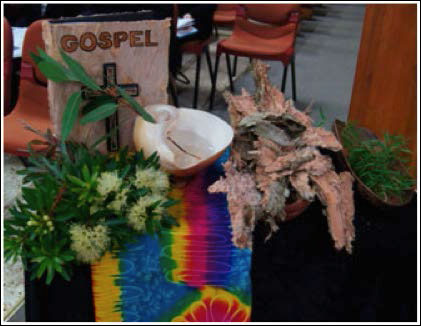 • A cloth in brown or red to symbolise the earth/Aboriginal and Torres Strait Islander material in brown or earthy colours.
• A cloth in brown or red to symbolise the earth/Aboriginal and Torres Strait Islander material in brown or earthy colours.
• Old shoes/footprints/decorated thongs with Aboriginal and Torres Strait Islander symbols
• Bible and Candle
• Aboriginal and Torres Strait Islander symbols provided by your local Aboriginal Catholic Ministry or group (Didgeridoo, Coolamon, clapsticks)
• Use Lectionary for Masses with Children (1992) and published notes for Leaders 18
Prayers
Creator God, we come together today.
We thank you for the ……………………………peoples who treasured and cared for the land we stand on.
We pray for them and we pray for us.
Holy Ground
The land we stand on is holy ground. It’s holy ground because we stand with each other. Its holy ground because we are made in the image of God. It’s holy ground because God loves each of us and God invites us to see each other as the
likeness of God.
Together
We pray that we can stand together.
We pray that we can walk together.
Help us to share our gifts with each other
Help us to listen to each other
Give us courage to walk with each other.
God of all people
Let us pray
God of all people, your Son, Jesus was rejected and forced to leave his own land.
We ask you to give us strength to walk with all our brothers and sisters, willingness to work together to be reconciled and courage to listen with an open heart and mind so that our sacred land of Australia, will be a place where everyone is welcomed, respected and celebrated.
We make this prayer in Jesus’ name.
Amen
Questions for Students
Today we think about Aboriginal and Torres Strait Islander people.
What type of journey have they walked?
How have they walked on this land?
An Indigenous person could tell a story of one of their journeys or explain how Aboriginal and Torres Strait Islander people showed their journeys through their art.
Do we know what it’s like to walk in someone else’s shoes?
What sort of footprint do we leave behind?
Is it one of respect, love, kindness or is it deep and destructive, heavy with hate?
Learning about the Traditional Custodians of the Land
 Step 1. Aboriginal and Torres Strait Islanders walked and cared for the land for many thousands of years. Contact your local Indigenous organisations, the Horton language map
Step 1. Aboriginal and Torres Strait Islanders walked and cared for the land for many thousands of years. Contact your local Indigenous organisations, the Horton language map
or do an internet search to find your local Traditional Owners and prepare a presentation on their:
• Language Group
• Dreaming Stories
• Lifestyle pre and post colonisation
• Neighbouring groups
• the ways Aboriginal people of the local/selected community expressed their connection to Country at time of colonisation.
It is important to understand the cultural practices and considerations of each Language group when learning about them.
In some groups it may not be culturally appropriate to share certain dreaming stories or talk about certain people. This is why it is important to work with your local group when completing this task.
Step 2. Pick an area of Australia in a different State and find the same information as you have on
your local group
Step 3. Compare the similarities and differences between the two groups.
Learning Outcomes:
1. Students comprehend and appreciate the diversity of Aboriginal and Torres Strait Islander Communities
across Australia
2. Students gain an understanding of the impact of colonisation on the lifestyle and culture of Aboriginal and Torres Strait Islanders.
3. Open Dialogue with local Aboriginal and Torres Strait Islander groups
4. Understand cultural systems and protocols.
Learning about Saints
Students might learn about Saints that are linked in some way with sharing, kindness and inclusion.
The Saints below are linked with Aboriginal and Torres Strait Islander people. St. Kateri is a Native American Saint and Sr. Mary MacKillop is the first Australian Saint.
St. Kateri Tekakwitha
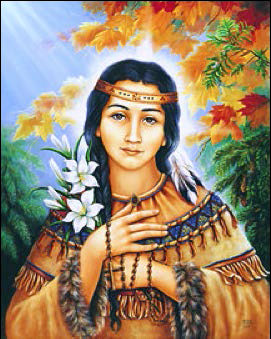 St. Kateri Takakwitha is the patron saint of the environment. She is the first Native American saint. She was born in 1656 to the daughter of a Mohawk warrior and a Catholic Alqonquin. Father Jacques de Lambertville, a Jesuit missionary baptized her.
St. Kateri Takakwitha is the patron saint of the environment. She is the first Native American saint. She was born in 1656 to the daughter of a Mohawk warrior and a Catholic Alqonquin. Father Jacques de Lambertville, a Jesuit missionary baptized her.
She was devoted to prayer and penitenial practices. She also cared for the sick and aged. At the age of four her mother and brother died of smallpox. Kateri’s face was scarred by the disease and she became almost blind. St. Kateri died during Holy Week. Within 15 minutes of death her face was healed of its scars.
She appeared to many people after her death, always carrying a cross. We celebrate St. Kateri’s feast day on July 14.
Saint Mary MacKillop
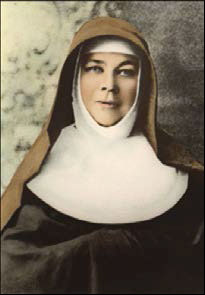 Saint Mary MacKillop is one of the most remarkable and inspiring women that Australia has produced. She dedicated her life to the Sisters of St Joseph, the first Religious order to be founded by an Australian, and in doing so, Saint Mary MacKillop provided an outstanding example that we as a society can follow.
Saint Mary MacKillop is one of the most remarkable and inspiring women that Australia has produced. She dedicated her life to the Sisters of St Joseph, the first Religious order to be founded by an Australian, and in doing so, Saint Mary MacKillop provided an outstanding example that we as a society can follow.
Despite a vow of poverty and a dependence on Divine Providence, Saint Mary managed to make education available to the poor and the marginalised people of rural Australia.
Even when faced with challenging times, Saint Mary refused to attack those who wrongly accused her and undermined her work. She continued in the way that she believed God was calling her, and was always ready to forgive those who wronged her.
Saint Mary showed compassion for anyone in need, regardless of race, colour or faith, and a reverence for the dignity of others, especially those most neglected in society.
Saint John Paul II's Address to Aboriginal and Torres Strait Islander people in Alice Springs 1986
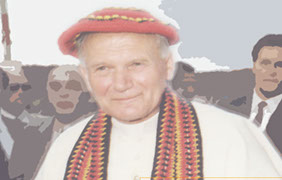 Jesus spoke directly to the hearts of Aboriginal and Torres Strait Islander people on 29 November 1986 in Australia’s heart – Alice Springs.
Jesus spoke directly to the hearts of Aboriginal and Torres Strait Islander people on 29 November 1986 in Australia’s heart – Alice Springs.
NATSICC has created a website that celebrates and explains the significance of the (then) Pope's visit and timeless speech.
Students can explore the site and be encouraged to complete one or more of the following activities (Courtesy of Archdiocese of Melbourne):
Ideas for Classroom Activities
1. Using the full text of the speech given by Pope John Paul II to the Aboriginal and Torres Strait Islanders
in 1986, explore the different themes presented in the text. How does the speech speak to our Australian culture today?
2. Write a blog expressing some of your thoughts and feelings.
Using only words and pictures design a poster that depicts the message of John Paul II to the Aboriginal and Torres Strait Islanders. Find a partner to explain the meaning of your picture.
3. Search for some quotes of Pope John Paul II, particularly his messages to youth. Choose one or two quotes that you really like. In small groups present your quotes explaining what you think they mean.
4. John Paul II travelled the world and met with many world leaders. Research some of the leaders and Heads of State that Pope John Paul II met. Choose one person/meeting that you think was interesting. Why was it interesting? Why was the meeting important?
Liturgy of the Word
Para-Liturgies are a great way for a class or two to explore worship outside the constraints of the Mass. The variety of participation is only limited by the organizer.
• Readings can be limited to a Gospel according to your chosen theme.
• Homily can be a shared discussion based on a brief commentary.
• Hymns/Music can relate to a theme – using the didge, clapsticks, recorded music, actions etc.
• Prayers of the faithful can be written by the children.
• Signs and symbols can be used in enhance the setting – Aboriginal colours and artefacts, native plants.
Drawings or paintings done by the children can be presented during the prayers of the faithful or shared homily.

National Aboriginal and Torres Strait Islander Catholic Council
'The peak Indigenous advisory body to the Catholic Church'
80C Payneham Rd.
Stepney SA 5069
www.natsicc.org.au | craig@natsicc.org.au | 08 8363 2963
